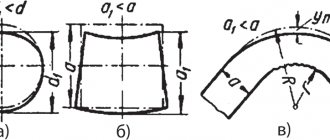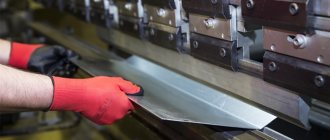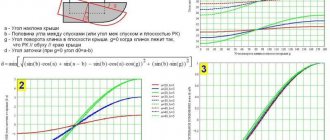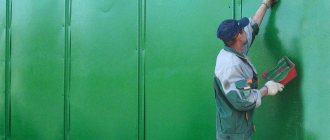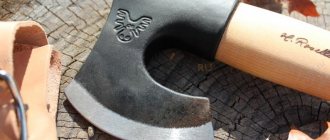04/29/2021 Author: VT-METALL
Issues discussed in the material:
- The essence of metal cutting
- Metal cutting methods
- Metal cutting tools
- Manual and mechanized metal cutting methods
- Possible defects when cutting metal
- Rules for safe work when cutting metal
- Price for metal cutting services
Metal cutting is a process that allows you to solve many different problems, ranging from the banal division of a workpiece into two or more parts and ending with the removal of burrs from a part. That is, this method of metal processing is very, very in demand.
At first glance, the work of cutting metal is not too difficult. However, like any other technology, it has its own nuances. If you don’t take them into account and do everything as you have to, the end result will most likely be completely different from what was originally planned.
The essence of metal cutting
A metalworking operation during which a workpiece is divided into several parts is called metal cutting. The separation of metal products is carried out according to special pre-applied markings. The cutting is performed along or across the workpiece. The advantage of this method of metal processing is that after completion of the process, minimal finishing work is required, which in turn affects the reduction in the cost of the finished part. Although sometimes the ragged edges of the finished product resulting from cutting may need sanding.
Despite some similarities, chopping and cutting metal products should not be confused:
- In the first case, to separate the workpieces, a blow with a sharp cutter is used in a specially designated place. The tool itself is positioned perpendicular to the surface being cut or at a slight angle to it.
- When cutting, parts are separated using special cutting tools (saws, scissors, automated equipment).
Metal cutting technology is used in the processing of pipes, fittings, metal rods of different sections, and sheet iron.
Metal cutting is a common metalworking operation used in cases where it is necessary:
- adjust the workpiece to a certain size;
- level the surfaces of the parts;
- separate scale;
- process the edges of the product;
- remove burrs from the workpiece;
- form edges for subsequent welding;
- cut out parts from metal sheets;
- cut off the mounting heads;
- form grooves and grooves.
Due to its wide range of applications, this operation is used both in small enterprises and in large engineering plants. Primitive cutting of sheet metal and other metal blanks can also be done at home.
The essence of cutting
Metal cutting is a metalworking operation that allows you to detach unnecessary elements (part, layer or defect) from the main workpiece. It helps to remove:
- scale;
- inaccuracies in dimensions if they arose during the production stage of the product;
- burrs.
You can also divide one workpiece into several different parts.
The process occurs by applying physical pressure through a stronger material. Typically, the blades use tool steel with added carbon, which has undergone additional heat treatment and hardening to increase strength. The iron being processed has a less stable chemical lattice, so intermolecular bonds are broken and non-plastic deformation occurs. Sometimes, to speed up the procedure, the sample is subjected to heat treatment.
Metal cutting methods
Metal cutting is classified depending on:
- the assigned task - they include sawing, cutting, removing a small part, a layer of the workpiece;
- driving force – divided into manual and automated/semi-automated cutting;
- forced fixation - processing using clamps, a vice, a special bed, a press is distinguished;
- directions of movement - distinguish between horizontal and vertical cutting.
When choosing a method for processing metal products, focus on:
- equipment used;
- workpiece thickness;
- the required level of quality of the finished part (are bent edges obtained by manual cutting acceptable, or is a more even and high-quality cut achieved when using automatic equipment necessary);
- productivity (to produce a large batch of parts you need special equipment; purchasing it in order to obtain one or several products is not economically feasible).
Plasma cutting
This auxiliary method of cutting metal has the following qualities:
- quickly, smoothly and efficiently cuts metal of any thickness;
- has compact dimensions;
- ease of use.
Despite the small list of advantages, plasma cutting has a lot of disadvantages, namely:
- Unsafe at work.
- Requires constant connection to oxygen cylinders;
- When using, you must carefully monitor the temperature, otherwise there is a risk of explosion.
- Working with plasma cutting requires the use of a protective helmet or lenses, as the high temperature and bright spark can blind a person.
- With its help you can only cut metal; it is impossible to bend or make channels in it.
Plasma cutting still has many disadvantages, but it is valued for its speed. With its help, you can cut sheet metal to size in a matter of minutes.
Metal cutting tools
The choice of tools for cutting metal depends on the technology used. For manual processing you will need:
- cutting tool (chisel, crossmeisel, etc.);
- a mechanic's hammer (of suitable weight and with a handle of appropriate length);
- vice;
- metal backing;
- tools for marking.
A bench chisel is used for standard cutting of metal workpieces and consists of:
- shock part;
- holder;
- working (cutting) surface.
The tool can be equipped with cutting surfaces of different shapes, depending on the task to be solved with its help.
The crossmeisel, unlike a chisel for chopping metal, has a narrower cutting edge. The working part of the groover is semicircular to make it more convenient to cut grooves in workpieces. The beard has the shape of a round rod with a cutting part sharpened along the perimeter of the circle. It is designed for cutting holes in sheet metal.
We recommend articles on metalworking
- Steel grades: classification and interpretation
- Aluminum grades and areas of their application
- Defects in metal products: causes and search methods
Durable steel is used to produce percussion instruments. They differ in geometric shapes and sharpening angles of the working surface. The top of the chisel is hit with a plumber's hammer. Hammers come with round or square strikers; they differ in the way the handle is attached and in weight.
To cut small metal parts and make holes, fastening equipment or steel substrates are used. Fix the workpieces with a vice.
Marking is carried out using metalwork rulers, squares, marking calipers, and small markers. Marks are applied to the workpiece using various cores, scribers with tips of different shapes, and pencils. Marking tools must meet certain standards.
VT-metall offers services:
Metal cutting at enterprises is carried out using special equipment:
- guillotines;
- hydraulic and mechanical presses;
- press scissors;
- angle cutting machines.
The power and high performance of the equipment allows you to work even with thick-walled metals.
The hydraulic guillotine for cutting metal is controlled using an electronic unit. Processing parameters, type of metal, cutting angle, pressure on the knife, and operating speed are entered into a special program.
Enterprises also use combined equipment:
- Cutting machines (press shears) – for working with profile metal blanks (channels, I-bars, squares), rolled metal, sheet and strip metals. Such equipment allows you to make even holes and grooves of various shapes in workpieces.
- Highly specialized equipment (angle notching machines, presses, stamps) - for angular cutting of workpieces, regardless of the thickness of the metal. A special scale and a properly sharpened chisel allow you to achieve highly accurate results. Presses and dies are equipped with mechanical, hydraulic, pneumatic and electric drives.
Definition
First of all, you need to decide what metal cutting techniques are, as well as their purpose. It is easy to understand that this process itself involves dividing an object into several parts. This is true for metal as well. This method is quite universal and can be used for almost all types of workpieces, from sheets and rods to pipes and large rolled products. Of course, different equipment will be required to solve these problems.
All types of cutting techniques have a basic similarity - they involve processing using a percussion or hydraulic tool that breaks through the metal. This is the main difference between the technology and cutting, in which the main type of influence is pressure.
Provided that a number of metal cutting rules are followed, the simplest operations can be performed at home. More complex work is usually carried out in a workshop, and in large enterprises various methods are used to mass produce products.
Before moving on to the next section, it is necessary to outline one more point, namely the relationship between cutting and chopping. Many companies specializing in metalworking do not share these methods for their clients. This approach gives more freedom in choosing the optimal processing method.
At the same time, cutting and chopping metal have many differences, the main ones being the method of influence and the tools used. Most locksmiths, not to mention large enterprises, use both technologies depending on the desired result.
Manual and mechanized metal cutting methods
- Manual cutting of metal.
The sequence of manual cutting of metal, performed horizontally or vertically, will be as follows. The workpiece is fixed with a vice. If this is not possible due to the thickness of the part, then it is placed on a special table. To minimize the sliding of the product, rubberized pads or screws screwed into the edges are used. After this, prepare the necessary tools: hammers, crosscutters or chisels.
Then you need to strike the workpiece. The impact can vary in strength, but is not necessarily severe. Initially, a notch is made on the surface of the metal part, which in the future will not allow the blade to move to the side. If you immediately apply full force, you can deform the workpiece and damage the tool. In the future, the impact force affects the cutting speed and the quality of the cut edges.
Depending on the swing, there are three types of strikes:
- carpal (lightest);
- elbow (medium in impact strength);
- shoulder (heaviest blow).
The longer the handle and the heavier the hammer, the stronger the blow.
Laser metal processing
Laser cutting of products is a progressive technique. Its essence is the effect of a narrowly directed light beam on the rolled product, heating the part at the point of contact to high temperatures. Under the influence of the beam, the metal product melts, and the remaining melt is blown off its surface with a special gas.
With the laser method, there is no deformation of the metal product, and it is possible to obtain a highly accurate result without the need for additional processing of the edges.
Scheme and general view of the installation
Despite all the advantages, these types of cutting metal products have several disadvantages:
- use only for thin sheet material up to 20 mm thick;
- the impossibility of processing aluminum alloys and stainless steel metal products due to their high reflectivity of light rays.
Possible defects when cutting metal
If metal cutting rules are not followed, there is a possibility of defects occurring, the most common of which are:
- curved cut edge;
- lack of parallelism of both edges of the resulting product;
- torn cut edge, burrs, roughness.
The causes of defects vary from person to person, but most often their appearance is caused by:
- unreliable fixation of the workpiece;
- displacement of parts and markings;
- incorrectly selected impact force.
To avoid deformation, before starting to cut metal, you should check:
- reliability of workpiece fixation;
- accuracy of combination of parts and markings;
- working tool sharpening parameters.
When cutting grooves, the following defects are also possible:
- torn edges;
- different groove depths;
- chips at the end of the groove.
To avoid defects during operation, it is necessary to act in accordance with the standards and procedures developed for specific equipment. The part, equipment and chopping tools must be prepared for work in advance. If the preparation for cutting and the operation itself are performed correctly, the edges of the part will be smooth, without defects or chips.
Kinds
Technological methods for eliminating defects in workpieces can include both manual and machine straightening methods. Repair work, in particular car body repairs, is carried out manually by qualified specialists with an individual set of tools and enormous experience.
In the mass production of metal structures, workpieces are brought to regulatory requirements using special, correct equipment. The machine straightening process is discussed in more detail in the article “Equipment for straightening metal.”
Straightening of sheet metal using special mechanical equipment. Photo Podolsk Equipment Plant
When used in the welding process, workpieces are deformed due to temperature stresses. Special devices can be made for straightening such workpieces. A workpiece forced into such equipment is subjected to thermal annealing, which returns it to its original state.
Rules for safe work when cutting metal
Before starting work, you must carefully inspect the equipment and check that it meets certain requirements:
- Hammers must fit firmly to the handles and be wedged into the hole using steel wedges with ruffs. Particular attention should be paid to the surface of the tool - cracks and chips are unacceptable, the surface should be smooth, slightly convex. The handle should thicken evenly towards the end. Knots, cracks, chips, and nicks on the handle are also unacceptable.
- There should be no cracks or chips on the chisel and crosspiece, the ribs on the sides of the middle part should be rounded and cleaned, the surface of the striking part should be smooth and slightly convex. The striking part of the chisel or crosspiece should be 2.5 cm from the thumb. The cutting edge of the chisel is straight or slightly convex with chamfers of the same width.
Before cutting metal using electrical equipment, you should check:
- Is the wire insulated or damaged?
- whether the ground wire is in contact with the body of the metal processing equipment;
- Are the gloves and mat in the workplace in good working order?
Before starting work on pneumatic equipment, you should check:
- serviceability of hoses;
- tightness of connections between hoses and pipelines and with cutting equipment;
- operation of the starting device.
When working, the mechanic must follow the safety rules:
- use safety glasses;
- To work with wedges or chisels, use sledgehammers and drifts with 70 cm holders; the drifts must be made of soft metal;
- securely fix the workpiece in a vice;
- direct the metal being cut or felled in the direction opposite to yourself;
- When working with sheet metal, use gloves;
- use protective nets (screens) when cutting large-sized workpieces, as well as parts made of hard metal.
Compliance with the listed safety rules is necessary to minimize the risk of injuries and accidents at work.
Drill
Drills come in feather and twist drills. The design of a feather drill is very simple and can be made by a mechanic himself by pulling back a steel bar. The disadvantage of this drill is that it does not remove chips that clog the hole, and that if the tip of the drill bit breaks when sharpening it, the diameter of the cutting edge is reduced. Feather drills can be used relatively successfully for brittle metals (cast iron, bronze).
Twist drills are used more often; they have two grooves made along a spiral, through which the chips are easily discharged out. The cutting edges are sharpened along the groove so that they form an angle of 116-118°. When sharpening correctly, the cutting edges should be the same length and located at the same angle to the drill axis. The correct sharpening of the drill is checked using the template.
Price for metal cutting services
The cost of cutting metal varies depending on various parameters, including the complexity of the work, the tools used, technology, etc.
Also, the formation of the price is influenced by the material from which the workpiece is made, the labor intensity of the process, the techniques used in the process of cutting metal, the presence or absence of additional work, the timing of the order, etc.
Let's first look at the cutting process using a chisel and a hammer.
The chisel has a wedge shape with its cutting part. The choice of sharpening angle largely depends on the hardness of the material being processed; the harder the material, the duller the wedge. Recommendations for choosing steel: the cutting wedge angle is 60 degrees; non-ferrous metals, the cutting wedge angle is 35 -40 degrees.
A special chisel is used to obtain grooves using a chisel. When processing by chopping, a hammer weighing up to 500 g is used.
